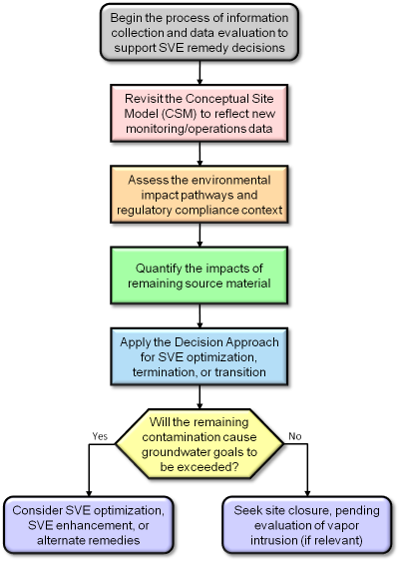Soil Vapor Extraction Performance Assessment
Soil vapor extraction, or SVE, is a prevalent remediation approach to removing volatile contaminants from the vadose zone. Over time, however, SVE may exhibit a diminishing rate of contaminant extraction due to shrinking contaminant mass and/or slow rates of removal for contamination in low-permeability zones. If this happens, SVE performance needs to be evaluated to determine whether the system should be optimized, augmented, terminated, or replaced by a different technology.

Guidance presented in the report, “SVE System Optimization, Transition, and Closure Guidance (PNNL-21843),” specifically addresses the elements of this type of performance assessment. A stepwise approach is suggested for gathering information and performing evaluations to support SVE remedy decisions, including:
- revisiting the conceptual site model;
- considering relevant information;
- quantifying the impact of remaining vadose zone contaminant sources on groundwater; and
- integrating the assessment outcomes into a decision logic approach to address optimization, transition, and closure decisions.
This material highlights relatively recent advances using mass flux/discharge approaches and includes a calculational tool to facilitate the evaluation process.
Soil Vapor Extraction Tool (SVEET)
The Soil Vapor Extraction Endstate Tool (SVEET) is a spreadsheet that allows users to easily enter information and obtain the estimated groundwater concentration results that are calculated for one or more scenarios conforming to the generalized conceptual model, which is described in the aforementioned report. Appendix C of the report, specifically, provides a convenient method for the user to apply the calculational procedures for estimating the impact of remaining vadose zone contaminant sources on groundwater concentrations and it walks the user through an example calculation. Appendix D of the report provides details about the SVEET software, including system requirements, installation, the user interface, and applications.
PNNL has updated SVEET as part of the U.S. Department of Defense’s (DoD) Environmental Security Technology Certification Program (ESTCP) project ER-201731. The update to SVEET2 permits an expanded range of input parameter values, thereby enhancing the applicability of the tool for DoD and other sites. The expansion involved conducting 5,760 simulations for variations in parameters with a nonlinear impact on the results (versus the 972 simulations underlying SVEET v. 1.0). VIETUS is superseded by SVEET2, which provides soil gas concentrations at a lateral location for sub-basement and sub-slab depths. The project included demonstration of SVEET2, which is documented in the project report. The SVEET2 software and associated report/user guide are available below.
Download the SVEET2 package
(Zip file is 26 MB)
Flow charts
File